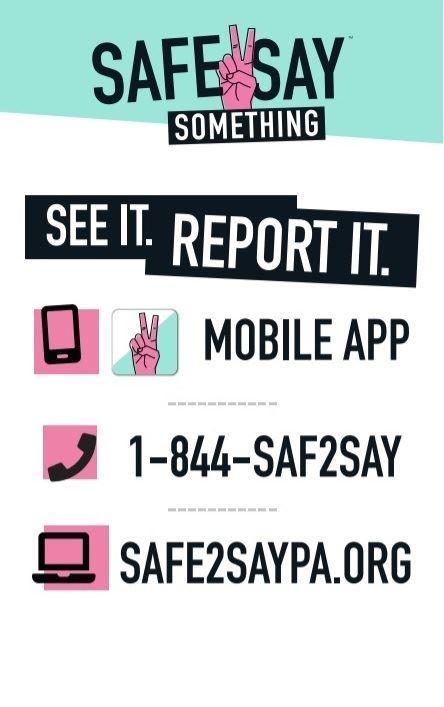Safe2Say Something
Archbishop Ryan High School participates in the Safe2Say Something PA reporting system.
Safe2Say Something PA is a PA school safety reporting system that accepts tips from students, parents, educators, and/or concerned community members on matters ranging from violence, suicide, guns, drugs, and threatening behavior to bullying, cyberbullying and other acts of victimization that impact students K-12 across the entire state of Pennsylvania. The Safe2Say Something PA app allows you to submit secure & anonymous safety concerns (“tips”) to a 24/7 Crisis Center. The Crisis Center triages and then forwards the tip to the appropriate school official and, when needed, to local law enforcement (through 911 dispatch). The purpose of the reporting system is to provide intervention and assistance for individuals at-risk of hurting themselves or others through violence or other potentially harmful actions.
Here’s how it works:
- Submit a tip report through the Safe2SaySomething system
- Crisis center reviews, assesses and processes all submissions
- Crisis center sends all submissions to school administration and/or law enforcement for intervention
- If needed, crisis center may contact tipster anonymously through the app
Is participation in the Safe2Say mandated by law?
The Safe2Say Something program is state mandated by Act 44 of 2018 and requires all K-12 schools, school districts, charter schools, private schools, cyber charter schools, private schools, nonpublic schools, intermediate units, and area vocational-technical schools operating in Pennsylvania to participate.
The Safe2Say Something program is state mandated by Act 44 of 2018 and requires all K-12 schools, school districts, charter schools, private schools, cyber charter schools, private schools, nonpublic schools, intermediate units, and area vocational-technical schools operating in Pennsylvania to participate.
How is this program funded?
The Commonwealth of Pennsylvania is funding the Crisis Center and its operations through Office of Attorney General and Sandy Hook Promise is funding training and education. There is no cost to school entities, dispatch and/or individuals who download and utilize the program.
The Commonwealth of Pennsylvania is funding the Crisis Center and its operations through Office of Attorney General and Sandy Hook Promise is funding training and education. There is no cost to school entities, dispatch and/or individuals who download and utilize the program.
Who Can Use the Safe2Say Anonymous Reporting System?
All students as well as their parents, staff, and other community members can use the anonymous reporting system. All students, grades 6-12, receive S2SS training to recognize warning signs, signals and threats and how to report a safety concern.
All students as well as their parents, staff, and other community members can use the anonymous reporting system. All students, grades 6-12, receive S2SS training to recognize warning signs, signals and threats and how to report a safety concern.
If I make a report, how can I be assured that reporting is anonymous?
The Say Something Anonymous Reporting System (SS-ARS) is extremely comprehensive in protecting the identity of tipsters - people who make reports to the crisis center. The system utilizes multiple external anonymous gateways to block IP addresses/phone numbers, and all phone calls received in the Crisis Center are blocked using a sophisticated multiple-level blocking system.
The Say Something Anonymous Reporting System (SS-ARS) is extremely comprehensive in protecting the identity of tipsters - people who make reports to the crisis center. The system utilizes multiple external anonymous gateways to block IP addresses/phone numbers, and all phone calls received in the Crisis Center are blocked using a sophisticated multiple-level blocking system.
The Attorney General's Office will NOT allow the anonymity of any tipster to be revealed without a court-ordered search warrant OR when there is a first-person reporting where or when the loss of life is imminent, anonymity will be uncovered as quickly as possible.
Be aware that they cannot guarantee that anonymity can be uncovered, especially 72 hours or more after a tip has been received, given the use of external gateways, challenges in tracking IP addresses, and possible use of public devices by a tipster.
How do parents find out that their child is in crisis or at risk to self or others? Does the call center reach out to them? How do they find out parent/student information?
There are two methods in which a parent may be informed that their child is in crisis and/or at risk to self or others – one or all approaches could be used for a given situation:
- School officials: All life-safety tips are provided to the school district to act upon. Therefore, a school official who receives and acts upon a tip could contact parents/guardians per school policy and protocols.
- Local Police: All life-safety tips are provided to local police to act upon. Therefore, in the event that police are either directly reaching out to a student (especially in an emergency) or working with the school district, contact could be made with a parent or guardian. The most likely scenario is through visiting an at-risk child in their home or post an emergency intervention. As a reminder, the school district is always informed of life-safety tips in order to work with local police
The Crisis Center, as part of the triage process of a tip or when corresponding with a first-person at-risk individual, will contact the school district Say Something Anonymous Reporting System (SS-ARS) administrator(s) to request parent/student information in an emergency situation only (defined as imminent possibility of loss of life) in order to pass this information to local police. The school district SS-ARS administrator, at the moment of the request, can make the decision to provide the contact information or work with police directly and not involve the Crisis Center.
 Archbishop Ryan High School
Archbishop Ryan High School


